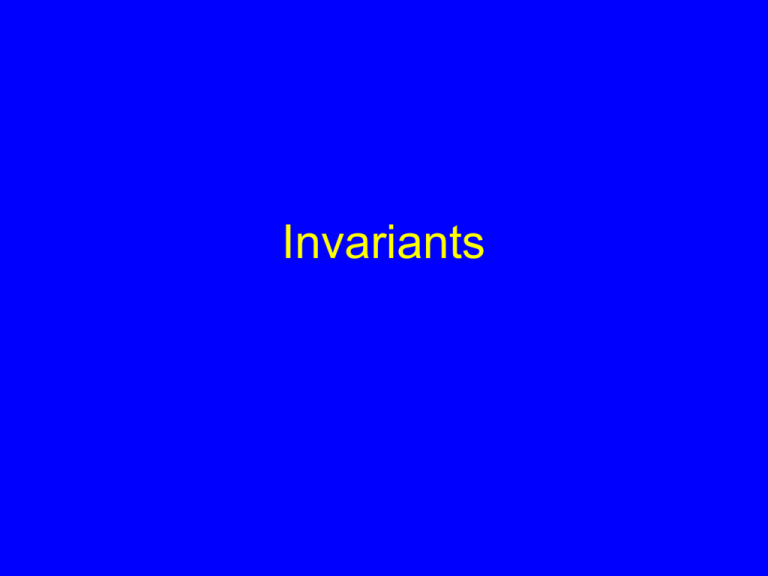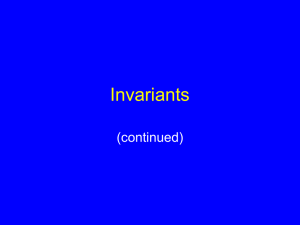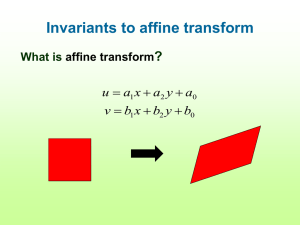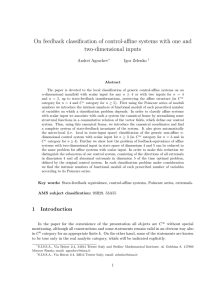Affine and projective geometry and invariants
advertisement

Invariants Definitions and Invariants • A definition of a class means that given a list of properties: – For all props, all objects have that prop. – No other objects have all properties • Invariant is an image property that: – For some objects, property is true for all images. – For all other objects, property is false for all images. Whiteboard • Definitions are composed of invariant properties. Invariants, a brief history • Invariance has long history in perception. Each movement we make by which we alter the appearance of objects should be thought of as an experiment desgned to test whether we have understood correctly the invariant relations of the phenomena before us, that is, their existence in definite spatial relations. – Helmholtz, 1878 If invariants of the energy flux at the receptors of an organism exist, and if these invariants correspond to the permanent properties of the environment … then I think thee is new support for … a new theory of perception in psychology. – Gibson, 1967 • In math, Erlanger program conceives geometry as study of invariant properties under a group of transformations. Our Plan • Projective Invariants. – Review projection. – Affine invariants (scaled orthographic projection of planar objects). – Projective invariants (planar, perspective). – Lack of invariants for 3D objects. • Illumination invariants. – Planar objects. – Non for 3D objects. The equation of projection (Forsyth & Ponce) The equation of projection • Cartesian coordinates: – We have, by similar triangles, that (x, y, z) -> (f x/z, f y/z, -f) – Ignore the third coordinate, and get x y (x, y, z) ( f , f ) z z Weak perspective (scaled orthographic projection) • Issue – perspective effects, but not over the scale of individual objects – collect points into a group at about the same depth, then divide each point by the depth of its group (Forsyth & Ponce) The Equation of Weak Perspective ( x, y , z ) s ( x, y ) • s is constant for all points. Projection • We’ll talk about a fixed camera, and moving object. • Key point: Some matrix x1 y1 P z 1 1 Points x2 y2 . . z2 1 . xn yn zn 1 s S s s 1, 2 s 2 ,1 s 2,2 s 1, 3 2,3 The image u u . . . I v v 1 2 I SP 1 Then: 1,1 2 t t x y u v n n Rotation r1,1 r2,1 r 3,1 r1, 2 r2, 2 r3, 2 r1,3 r2,3 P r3,3 Represents a 3D rotation of the points in P. Simple 3D Rotation cos sin 0 sin cos 0 0 x 0 y 1 z 1 x 1 y 1 z 2 . . . 2 2 Rotation about z axis. Rotates x,y coordinates. Leaves z coordinates fixed. x y z n n n Full 3D Rotation cos R sin 0 sin cos 0 0 cos 0 0 1 sin 0 sin 1 0 1 0 0 cos 0 cos 0 sin 0 sin cos • Any rotation can be expressed as combination of three rotations about three axes. 1 0 0 RR 0 1 0 0 0 1 T • Rows (and columns) of R are orthonormal vectors. • R has determinant 1 (not -1). Full 3D Motion/Projection 3D Translation r Scale 1,1 r r 2 ,1 r r 3 ,1 r r 0 0 1 0 0 t r 1 0 0 s 0 1 0 t r 0 1 0 0 0 1 t Projection 0 x y z 1, 2 2,2 3, 2 1, 3 2,3 3,3 0 0 P 0 1 3D Rotation s s s s where 1,1 1, 2 s 2 ,1 2,2 s 1, 3 2,3 st P st x y (s , s , s ) (s , s , s ) 0 1,1 1, 2 1, 3 2 ,1 2,2 2,3 (s , s , s ) (s , s , s ) 1,1 1, 2 1, 3 2 ,1 2,2 2,3 We can just write stx as tx and sty as ty. Invariants on a line • WLOG, line is y=0,z=0. x x . . t 0 0 t 0 0 1 1 x . . . x 1 1 1 u v 1 u 2 1 v 2 . . . u s v s n 1,1 s 1, 2 s n 2 ,1 s 2,2 s s s 1,1 2 ,1 1, 3 2,3 t x t 1 x 1 y 2 x y 2 . x 0 0 1 n n Then, we can show that ||p3-p2||/||p2-p1|| is invariant to this transformation. whiteboard Planar Invariants u v 1 u 1 v 2 2 . . . u s v s n 1,1 s 1, 2 s n 2 ,1 s 2,2 s s s 1, 3 2,3 1,1 s 1, 2 t 2 ,1 s 2,2 t A t x y x x t y y t 0 0 1 1 x x . y y 1 1 x 1 2 1 2 . . x y 0 1 . n n y 1 2 1 2 . . x y 1 n n p3 p4 We call (a,b) affine coordinates of p4. p1 p2 p4 = p1 + a(p2-p1) + b(p3-p1) A(p4)+ t = A(p1+a(p2-p1) + b(p3-p1)) + t = A(p1)+t + a(A(p2)+t – A(p1)-t) + b(A(p3)+t – A(p1)-t) p4 is linear combination of p1,p2,p3. Transformed p4 is same linear combination of transformed p1, p2, p3. Perspective Projection • Problem: perspective is non-linear. • Solution: Homogenous coordinates. – Represent points in plane as (x,y,w) – (x,y,w), (kx, ky, kw), (x/w, y/w, 1) represent same point. – If we think of these as points in 3D, they lie on a line through origin. Set of 3D points that project to same 2D point. Perspective motion and projection r 1 0 0 t r 0 1 0 t 0 0 1 t r 0 1,1 x 2 ,1 y 3 ,1 z r 1, 2 r 2,2 r 3, 2 0 r 1, 3 r 2,3 r 3,3 0 0 x r 0 y r 0 z r 1 1 1,1 r r 2 ,1 r r 3 ,1 r r 1, 2 2,2 3, 2 1, 3 2,3 3,3 x t y t z t 1 x y z For Planar Objects r r r 1,1 r r 2 ,1 r r 3 ,1 r r 1, 2 2,2 3, 2 1, 3 2,3 3,3 x t r y t r 0 t r 1 x 1,1 r y 2 ,1 r z 3 ,1 r 1, 2 2,2 3, 2 t x t y t 1 x y z The first two columns on right are orthonormal. Scale is irrelevant. So there are 6 degrees of freedom. We ignore constraints to get 8. This is called a projective transformation. Projective Transformations • Mapping from plane to plane. • Form a group. – They can be composed – They have inverses. – Projective transformations equivalent to set of images of images. Planar Projective Invariants • Strategy. – Suppose P represents five points. V1 transforms P so that first 4 to canonical position, and fifth to (a,b,c). – Next, suppose we are given TP, with T unknown. Find V2 to transform first 4 points of TP to canonical position. – V2 = V1*T-1. V2P has fifth point = (a,b,c). – For this to work, V1, V2 must be uniquely determined. Transform to Canonical Position Example: transform point 1 to (0,0,1). Three linear equations with 8+1 unknowns. a d g b e h c x 0 f y k 0 1 1 1 1 1 1 Similarly, transform other points to: (1,0,1), (0,1,1), (1,1,1). Get 12 equations, 4 unknowns. • Unique solution. • Must be non-degenerate. This will be true if no three points collinear. Affine • Affine transformations are a subgroup of projective, with last row = (0,0,1). • Note that this is equivalent to what we did in the affine case. Affine coordinates are coordinates of 4th point after first three are transformed to (0,0), (1,0), (0,1).








